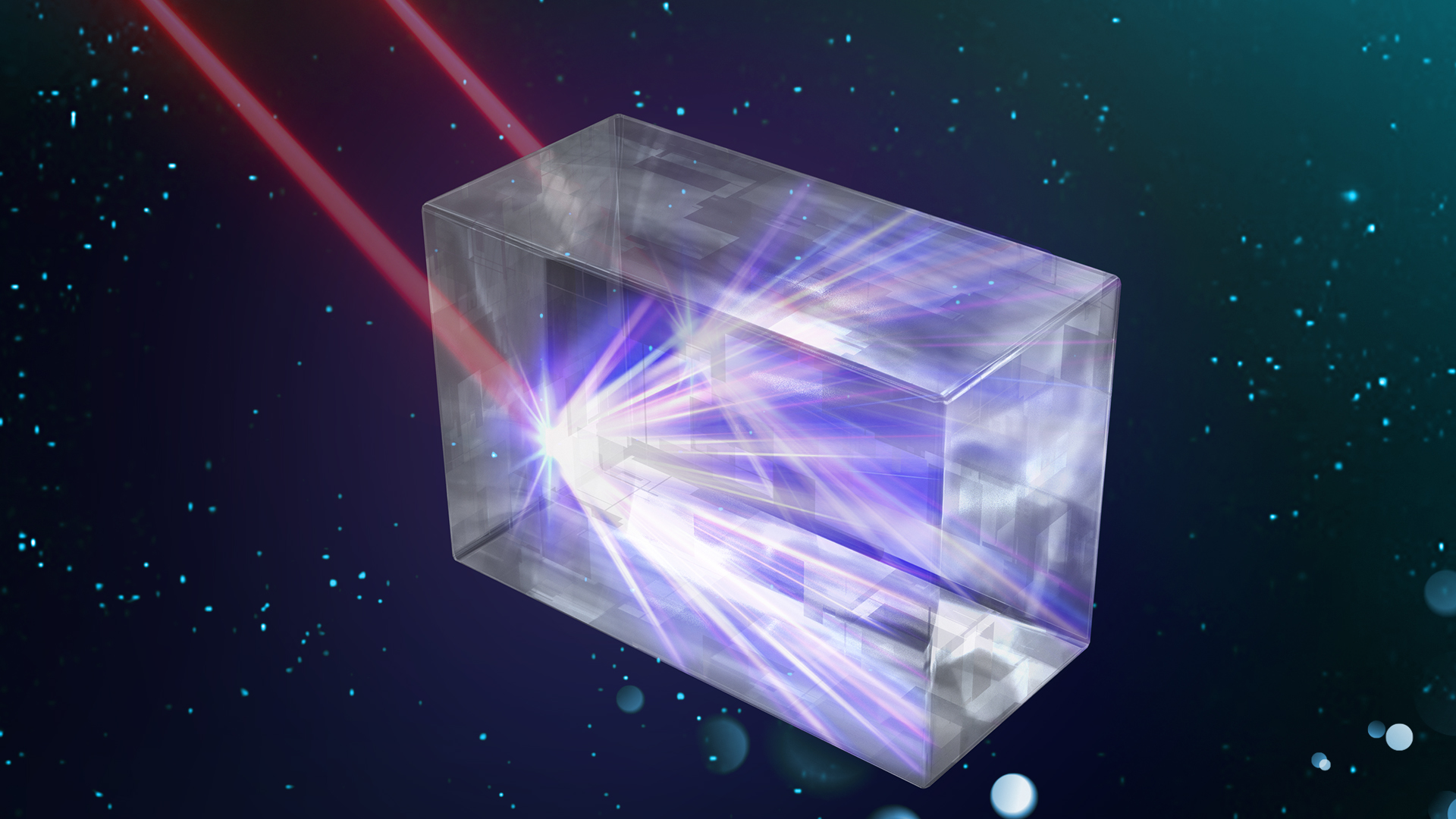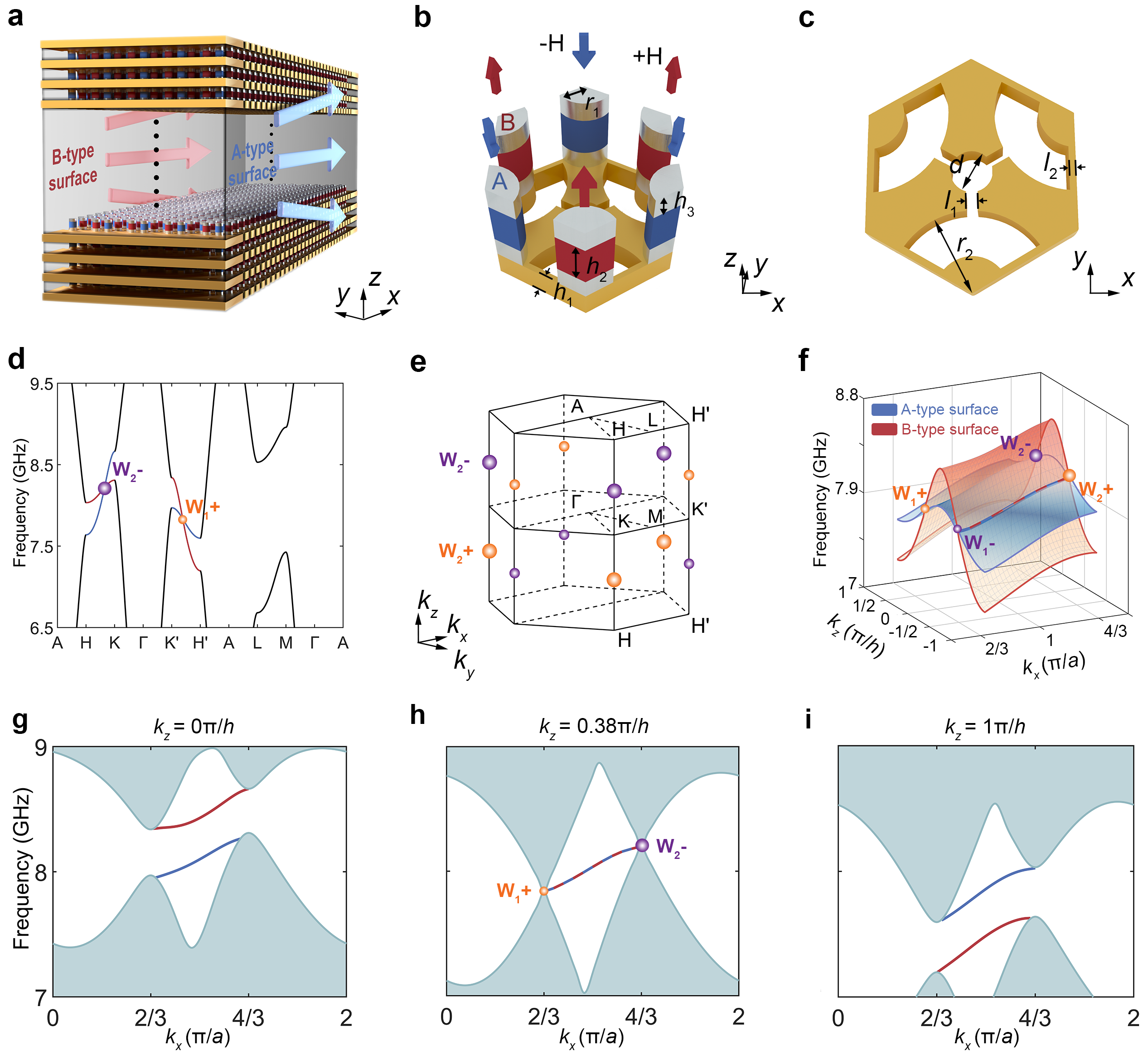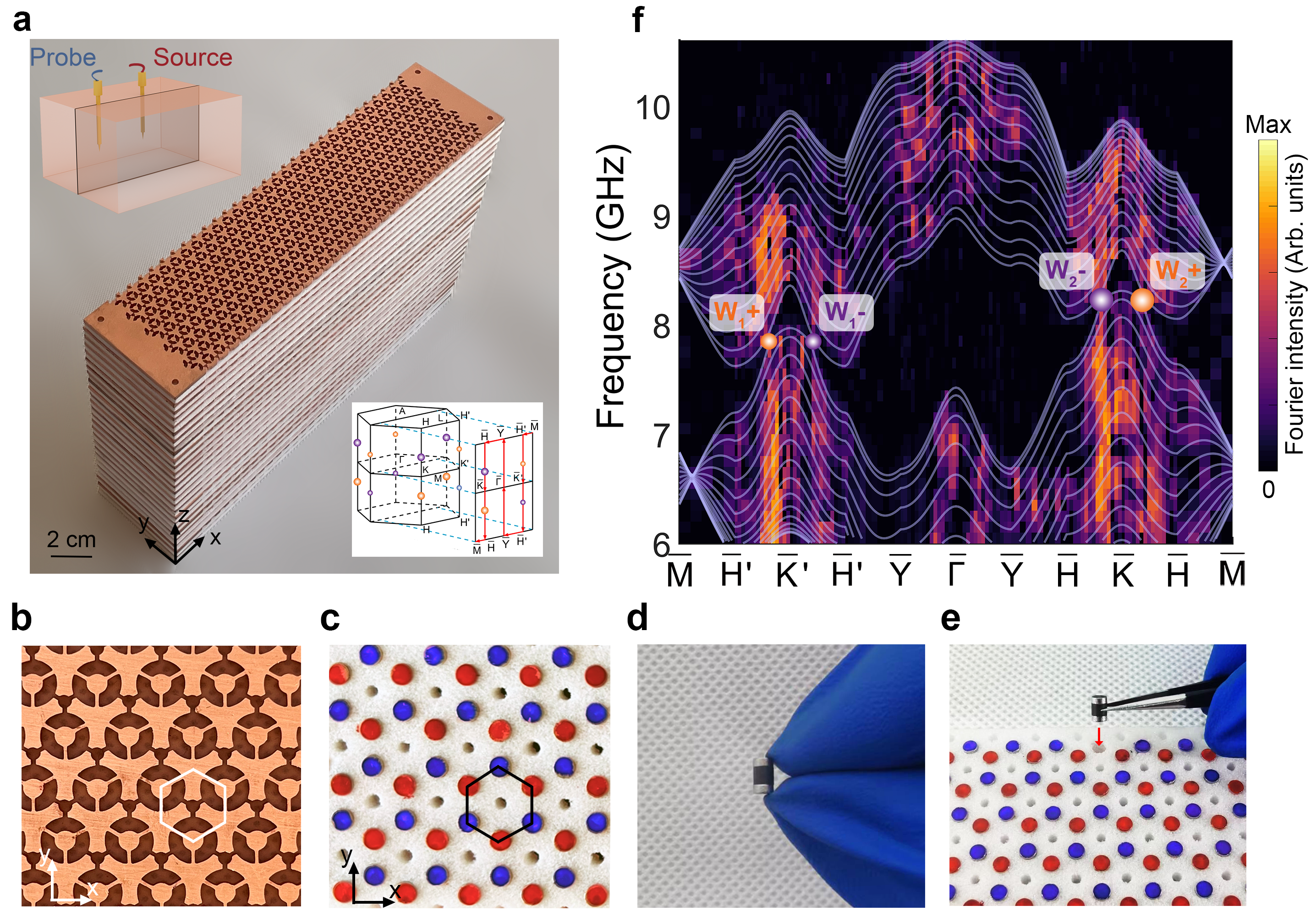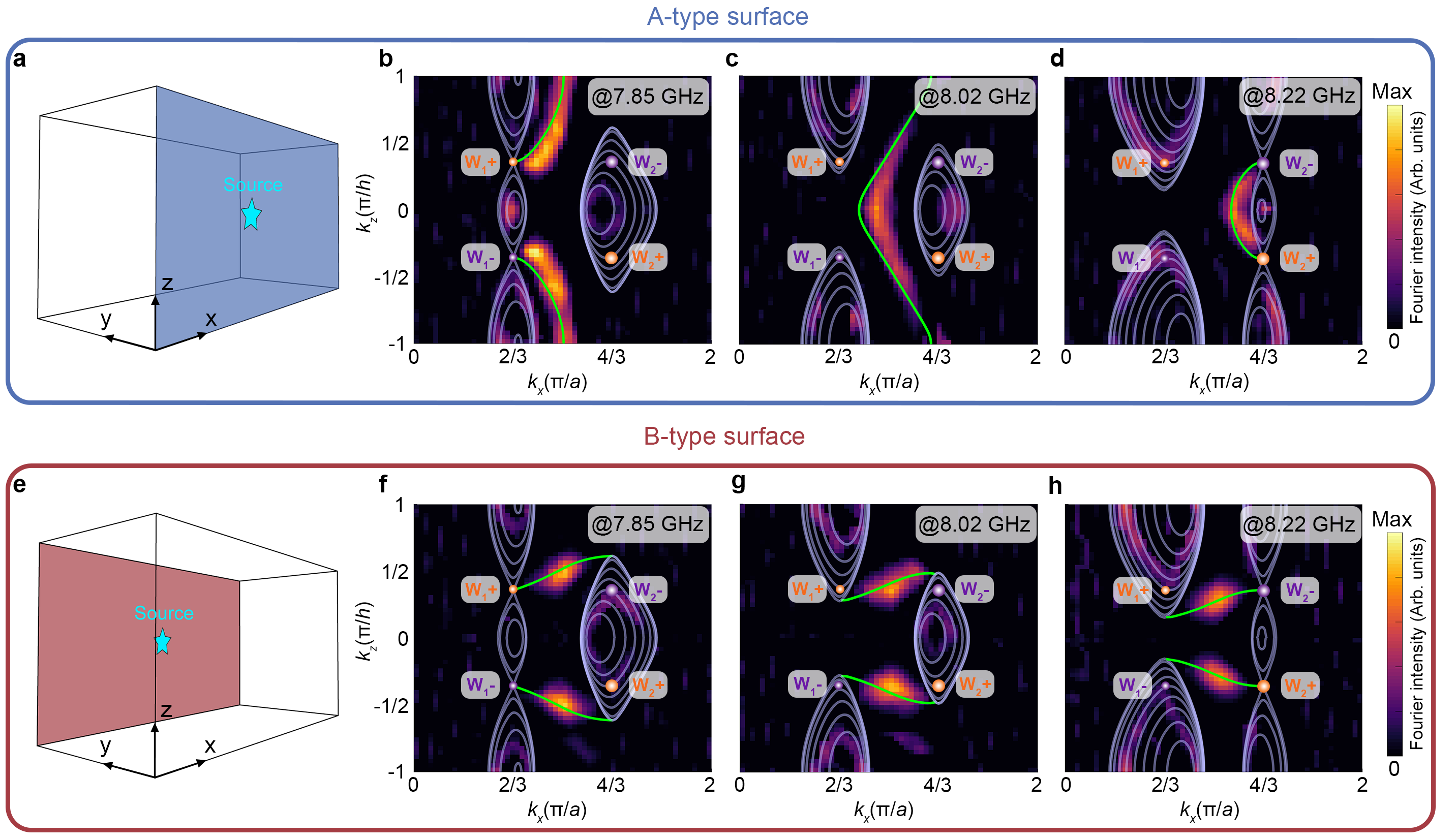Chiral edge states that propagate oppositely at two parallel strip edges are a hallmark feature of Chern insulators, which were first proposed in the celebrated two-dimensional (2D) Haldane model in the 1980s, as shown in Fig .1(a). Subsequently, counterintuitive antichiral edge states that propagate in the same direction at two parallel strip edges were discovered in a 2D modified Haldane model, as shown in Fig .1(b).
Recently, chiral surface states, the 2D extension of one-dimensional (1D) chiral edge states, have also been observed in a photonic analogue of a 3D Haldane model, as shown in Fig .1(c). Researchers have previously inspired a natural question: Can we extend the chiral topological edge states to 2D and thus realize chiral topological surface states? Similar to the antichiral edge states, the antichiral surface states are supposed to propagate in the same direction along two parallel cuboid surfaces, as illustrated in Fig. 1(d). However, there is no study (even in theory) of the antichiral surface states so far.

Associate Professor Zhen Gao’s research group from the Department of Electronic and Electrical Engineering at the Southern University of Science and Technology (SUSTech) has recently reported the first experimental observation of antichiral surface states by constructing a 3D modified Haldane model in a magnetic Weyl photonic crystal with two pairs of frequency-shifted Weyl points (WPs).
Their paper, entitled “Topological antichiral surface states in a magnetic Weyl photonic crystal,” has been published in Nature Communications [Nat. Commun. 14 1991 (2023)], one of the most prestigious journals in the world.

Figure 1. Topological states have been realized in magnetic photonic crystals
To achieve the antichiral surface state, Prof. Gao’s group started by extending the 2D modified Haldane model to 3D, and implemented this 3D tight-binding model with a three-dimensional magnetic photonic crystal. Using microwave near-field imaging measurements, they observed a unique photonic, magnetic Weyl semimetal with two pairs of frequency-shifted WPs and counterintuitive antichiral surface states. A three-dimensional magnetic photonic crystal can be obtained by stacking two-dimensional honeycomb lattice magnetic photonic crystals and introducing interlayer coupling, where the two triangular sub-lattices of A and B sites are magnetized along –z and +z directions, as shown in Fig. 2(a).
Figs. 2(b) and 2(c) are the 3D honeycomb unit cell and perforated metallic plate. Fig. 2(d) shows the simulated bulk band structure of the 3D gyromagnetic Weyl photonic crystal, which hosts two pairs of frequency-shifted WPs pairs. This novel phenomenon can only occur in both inversion and time reversal symmetries broken system, which is another unique unrevealed feature of magnetic Weyl semimetals, besides the robust chiral surface states, minimal number of WPs, and the simplest single open Fermi arc.
Fig. 2(e) shows the 3D bulk Brillouin zone with the WPs marked by purple and orange spheres. Fig. 2(f) shows the calculated Fermi arc surface states dispersions of A-type (blue color) and B-type (red color) surfaces, respectively. Due to the frequency shift of two WPs pairs, both Fermi arc surface state dispersions tilt along the +kx direction with positive group velocities, indicating that two surface states on A-type and B-type surfaces propagate along the same direction. The frequency-dependent surface dispersion curves along kx direction with kz = 0π/h, kz = 0.38π/h, and kz = 1π/h, respectively, as shown in Fig. 2(g-i).

Figure 2. 3D magnetic Weyl photonic crystal and simulated antichiral surface states
The fabricated experimental sample is shown in Fig. 3(a). The partially enlarged photo of the perforated copper plates and dielectric foams inserted with gyromagnetic rods and magnets are displayed in Figs. 3(b) and 3(c), respectively. The gyromagnetic rods are sandwiched between a pair of magnets with corresponding magnetization directions and then inserted into the dielectric foam to fix their positions, as shown in Figs. 3(d) and 3(e), respectively.
The researchers excite the bulk state of the 3D magnetic Weyl photonic crystal, then use microwave near-field imaging measurements to obtain complex field distributions. After applying Fourier transform to these distributions, they obtain the measured projected bulk band structure, as shown in Fig. 3(f), which is consistent with the calculated projected bulk band structure. From both the measured and simulated results, two pairs of WPs (purple and orange spheres) with a frequency shift can be observed.

Figure 3. Experimental demonstration of the bulk states in 3D magnetic Weyl photonic crystal
To explore the unique topological antichiral surface states supported by this magnetic Weyl photonic crystal, the researchers cover both A-type and B-type surfaces of the experimental sample with copper claddings. They repeat the field mapping measurements with the point source placed at the center of the A-type and B-type surfaces, respectively, and conduct Fourier transform to the measured surface field distributions.
For the A-type and B-type surfaces, the measured iso-frequency contour of the surface states (background color maps) at three different frequencies are plotted in Figs. 4(b-d) and 4(f-h), respectively, where the white solid lines represent simulated bulk states and solid green lines represent simulated surface states. Both experimental and simulated results show that the two surfaces of 3D magnetic Weyl photonic crystal exhibit different Fermi arc surface states, where the surface state iso-frequency contours of the A-type surface can evolve from a single open Fermi arc to a single surface Fermi loop and finally to a single open Fermi arc as the frequency changes. In contrast, for the B-type surface, its surface state iso-frequency contours keep unchanged with two open Fermi arcs as the frequency changes.

Figure 4. Experimental demonstration of surface state iso-frequency contours of antichiral surface states
To further demonstrate the antichiral properties of topological surface states in the magnetic Weyl photonic crystal, Figs. 5(a-c) and 5(d-f) present the frequency-dependent surface dispersions within different kz slices for the A-type and B-type surfaces, respectively, in which the background color maps represent the measured results, the white (green) solid lines represent the simulated bulk (surface) dispersions.
At kz = 0π/h and kz = 1π/h, for the A-type surface, the projected bulk bandgap opens, and the surface states connect the projections of the lower (upper) bulk bands. In contrast, the situations are reversed for the B-type surface, as shown in Fig. 5(d) and 5(f). At kz = 0.38π/h, for both the A-type and B-type surfaces, the Fermi arc surface states connect the projections of two frequency-shifted WPs. Remarkably, for both A-type and B-type surfaces with any kz, their topological surface states dispersions always exhibit overall positive slopes along the +kx direction, further confirming the existence of antichiral surface states.

Figure 5. Experimental demonstration of surface dispersions of antichiral surface states
Xiang Xi, Bei Yan, and Linyun Yang, all of whom are postdoctoral fellows from the Department of Electronic and Electrical Engineering at SUSTech, are the co-first authors of this paper. Assoc. Prof. Zhen Gao from SUSTech, Prof. Baile Zhang and Dr. Gui-Geng Liu from Nanyang Technological University are the co-corresponding authors. SUSTech is the first affiliation.
This research was supported by the National Natural Science Foundation of China (NSFC), Fundamental Research Funds for the Central Universities, Excellent Young Scientists Fund Program (Overseas) of China, National Key Research and Development Program of China, and SUSTech.
Paper link: https://www.nature.com/articles/s41467-023-37710-7
To read all stories about SUSTech science, subscribe to the monthly SUSTech Newsletter.
Proofread ByAdrian Cremin, Yingying XIA
Photo By